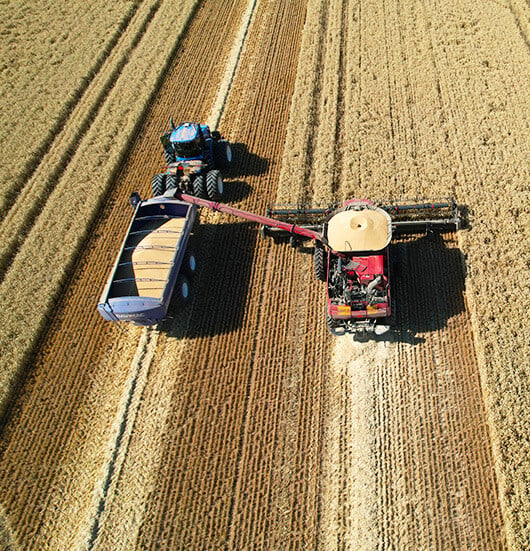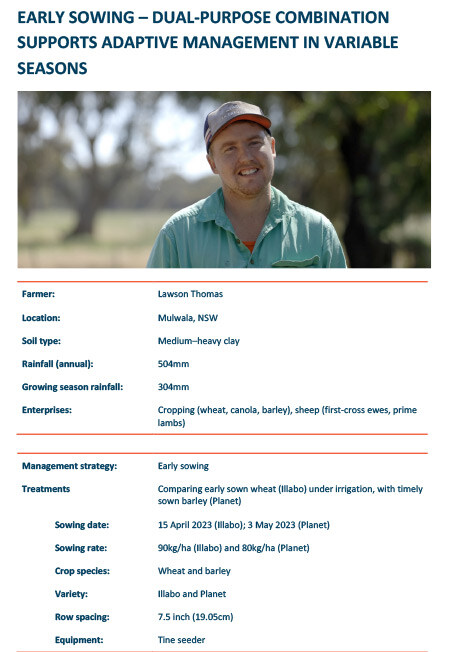Case study: Early sowing of longer-season varieties with Lawson Thomas

Publication date
19 Nov 2024
Publication partner
This project publication is supported through funding from the Australian Government’s Future Drought Fund Drought Resilient Soils and Landscapes Grants Program and is co-funded by the Grains Research and Development Corporation.
This case study was compiled by Riverine Plains.
OPTIMAL SOIL AND WATER MANAGEMENT INCREASES DROUGHT RESILIENCE — FROM THE PLOT TO THE PADDOCK
Drought is an inevitable part of farming in Australia, but outcomes from the Improved drought resilience through optimal management of soils and available water project are equipping farmers with a host of additional strategies with which they can prepare for the inevitable.
Numerous small-scale field trials across southern NSW have shown that early sowing of slower-maturing crops, diverse legume rotations and nitrogen banking can all increase profitability and productivity by increasing soil moisture availability and preventing carbon and nutrient loss under drought conditions. But proving these practices are profitable on a paddock scale is key to ensuring grower adoption.
Using on-farm demonstrations, this project has demonstrated how growers can apply the theoretical strategies profitably on a paddock scale, across different soil types, environments and land uses.
Charles Sturt University, under the Southern NSW Drought Resilience Adoption and Innovation Hub, led the project in partnership with Farming Systems Groups Riverine Plains, FarmLink Research, Central West Farming Systems and Southern Growers, in collaboration with CSIRO and the NSW Department of Primary Industries. The collaboration saw management strategies that had been tried and tested by researchers, over six years on four sites, validated on farm with growers and advisors.
The project was supported through funding from the Australian Government’s Future Drought Fund Drought Resilient Soils and Landscapes Grants Program and is co-funded by the Grains Research and Development Corporation.
EARLY SOWING OF LONGER-SEASON VARIETIES
Research carried out by CSIRO in small-scale plot trials indicates early sowing of longer-season varieties can provide multiple benefits depending on the weather and type of enterprise. Early sowing can:
- utilise residual soil moisture from late summer or an early season break
- match crop phenology with the sowing date, capturing optimal flowering windows and reducing the risk of adverse seasonal conditions
- offer dual-purpose options, such as integrating grazing into the farming system
- provide logistical advantages by lengthening the sowing window.
EARLY SOWING – DUAL-PURPOSE COMBINATION SUPPORTS ADAPTIVE MANAGEMENT IN VARIABLE SEASONS
Case study with Lawson Thomas
Location: Mulwala, NSW
Soil type: Medium–heavy clay
Rainfall (annual): 504mm
Growing season rainfall: 304mm
Enterprises: Cropping (wheat, canola, barley), sheep (first-cross ewes, prime lambs)
Management strategy: Early sowing
Treatments: Comparing early sown wheat (Illabo) under irrigation, with timely sown barley (Planet)
Sowing date: 15 April 2023 (Illabo); 3 May 2023 (Planet)
Sowing rate: 90kg/ha (Illabo) and 80kg/ha (Planet)
Crop species: Wheat and barley
Variety: Illabo and Planet
Row spacing: 7.5 inch (19.05cm)
Equipment: Tine seeder
AT A GLANCE
- Early sowing allows farmers to capitalise on favourable weather patterns (early moisture) and extend their growing season to reduce the risk of adverse weather conditions later in the season, with or without grazing.
- Dual-purpose crops boost the feedbase and reduce the feed gap over the winter months.
After incorporating an early sown crop of Illabo wheat into his cropping program for the first time in 2023, Mulwala farmer Lawson Thomas is convinced of the benefits of the innovative practice. Not only did the dual-purpose crop provide bountiful additional feed, boosting his grazing operation, it went on to yield more than 5t/ha of quality grain.
“Early sowing isn’t something we have done in the past — it’s not something we would normally do as part of our conventional cropping program,” Lawson admitted.
“Boosting our feedbase for our sheep enterprise, having the option to produce hay or silage if needed, reducing feed gaps over the winter and running higher winter stocking rates is definitely a bonus, and something we will continue to do as part of our mixed-farming operations into the future.”
The Thomas family traditionally implements a wheat–canola–barley rotation across their 1000ha property. Having a smaller cropping program allows them to sow paddocks during the optimal sowing window — at standard sowing times — without the need to start sowing early. But the ability to boost their feedbase and provide additional options and flexibility in their farming system, particularly under irrigation, saw the mixed-farming operators trial the system during 2023 as part of the Improved drought resilience through optimal management of soils and available water project.
“After pre-watering the paddock, two applications of 25mm irrigated rainfall, and a pre-emergent spray, we sowed Illabo wheat under the centre pivot on 15 April 2023,” Lawson said.
“We put 1500 ewes and lambs on the 100ha paddock for six weeks during July as the crop matured and they didn’t even make a dent in it. There was ample feed in front of the mob — they couldn’t keep up with it.”
“The crop was quick to bounce back and proceed to grain fill after Lawson removed the sheep from the paddock, yielding 5.1t/ha at the end of the season.
“It was great to have the extra feed available during the season, while still being about to take the crop through to harvest with a reasonable grain yield,” Lawson said.
REAPING THE BENEFITS OF EARLY SOWING
Early sowing allows farmers like Lawson to capitalise on favourable weather patterns (early moisture). It also allows them to extend their growing season to reduce the risk of adverse weather conditions later in the season, with or without grazing.
Riverine Plains Project Officer Rhiannan McPhee said, “more and more we are seeing farmers able to select varieties and sowing windows that will result in good outcomes in terms of feed and grain yields.”
Rhiannan emphasised the key to optimising grain yield is to remove stock before stem elongation so as not to remove the reproductive heads.
“Grain yield is also impacted by residual biomass, so it’s important farmers allow enough time for crops to recover post-grazing,” she noted.
“When water is available, they are confident to sow early and utilise dual-purpose crops in their systems. But under drier conditions, they tend to place less emphasis on post-grazing yields.”
“It’s also important farmers understand their soil conditions at the start of the season, as well as during the season to achieve positive outcomes with early sowing.”
Plant counts were taken at crop emergence in both the irrigated and dryland paddocks, to assess potential differences in crop establishment.
“There was a significant difference between the paddocks — the irrigated paddock had a higher plant count — rather than a notable difference between early and standard sowing times,” Rhiannan explained.
Table 1 shows the pre-sowing and post-harvest soil test results for the irrigated and dryland paddocks.
TABLE 1. SOIL TEST RESULTS — 2023, MULWALA NSW.
| PROPERTIES | DEPTH (CM) | IRRIGATED + GRAZED ILLABO WHEAT (EARLY) | DRYLAND PLANET BARLEY (STANDARD) | ||
| Pre-sowing | Post-harvest | Pre-sowing | Post-harvest | ||
| Nitrogen (kg N/ha) | 0–90 | 127.4 | 41.6 | 71.9 | 13.2 |
| Soil moisture (PAW mm) | 0–90 | 110.8 | 145.0 | 318.6 | 248.0 |
Biomass cuts were taken before harvest from the early sown paddock to calculate harvest index, yield and seed protein estimates. Yield measurements were also taken at harvest (see Table 2).
TABLE 2. YIELD MEASUREMENTS FOR EARLY SOWN ILLABO WHEAT — 2023, MULWALA NSW.
| ILLABO WHEAT (IRRIGATED + GRAZED) | |
| Total dry matter (t/ha) | 17.73 |
| Harvest index | 0.36 |
| Actual grain yield (t/ha) | 5.10 |
The wet season saw Lawson apply fungicide to the crop under the centre pivot earlier than he would normally. While fungicide applications are often applied as part of their conventional sowing program, Lawson believes fungicide applications could increase depending on the scale of the program under irrigation with seasonal conditions and appetite to risk.
Concerns with increased frost susceptibility and lodging of early sown varieties are something that are front and centre of mind for Lawson. But despite this, he believes the benefits of early sowing still outweigh the potential challenges.
“Good drainage in paddocks plays a crucial role in preventing waterlogging and lodging issues,” he said.
“Increasing our urea applications would also optimise yields.”
LOOKING TO THE FUTURE
The inclusion of dual-purpose varieties in his rotation as a risk management tool, is something Lawson is keen to continue into the future.
“The more options and flexibility in our system the better,” he said.
“Early sowing with dual-purpose crops allows us to respond in a timely manner to seasonal fluctuations in the weather and livestock prices.”
Lawson is conscious the benefits of early sowing need to be balanced against the increased risk of frost damage as the crops mature.
“The increased chance of frost damage and crop loss with earlier-sown varieties is something we will definitely consider when making decisions around paddock selection into the future. Careful paddock selection — sowing earlier varieties on our higher country — will help to mitigate the frost risk.”
Despite the risk, Lawson is keen to embrace the benefits of early sowing in his mixed farming system.
“Dual-purpose crops will also assist us to re-establish clean pastures after the cropping phase,” Lawson added.
Looking to 2024, Lawson will grow dual-purpose crops on his dryland country, so will be watching the weather forecasts and hoping for rain early in the season.
This project is supported through funding from the Australian Government’s Future Drought Fund Drought Resilient Soils and Landscapes Grants Program and is co-funded by the Grains Research and Development Corporation.
Resources
See more case studies and videos from the Improved drought resilience through optimal management of soils and available water project.
NEWS
Discover unique perspectives on agriculture from across the Riverine Plains.
-
Livestock
-
People
-
Grains
-
Sustainability

